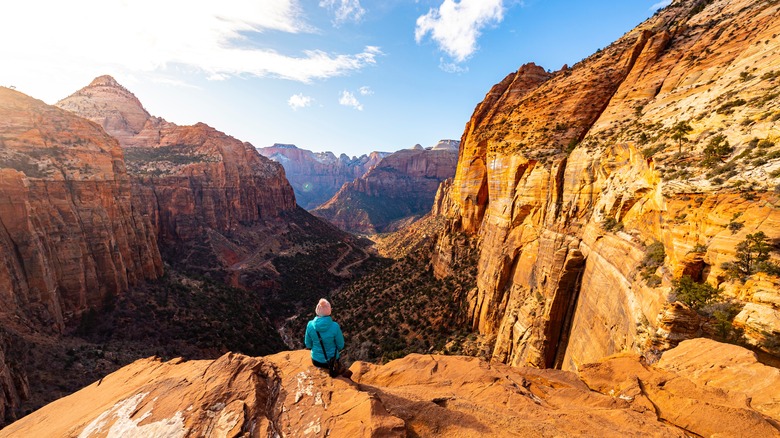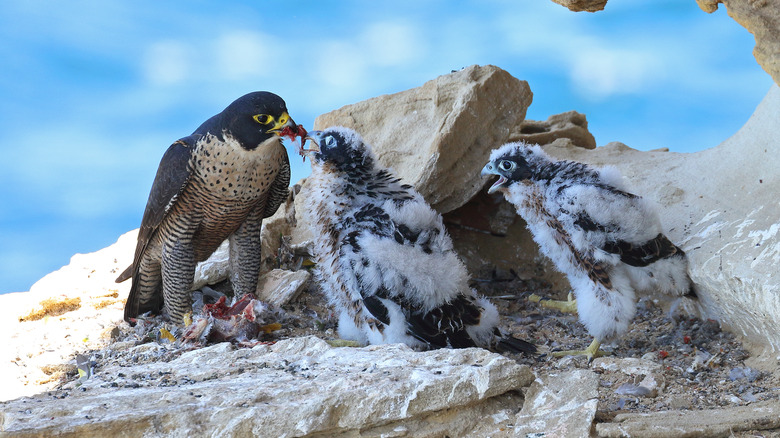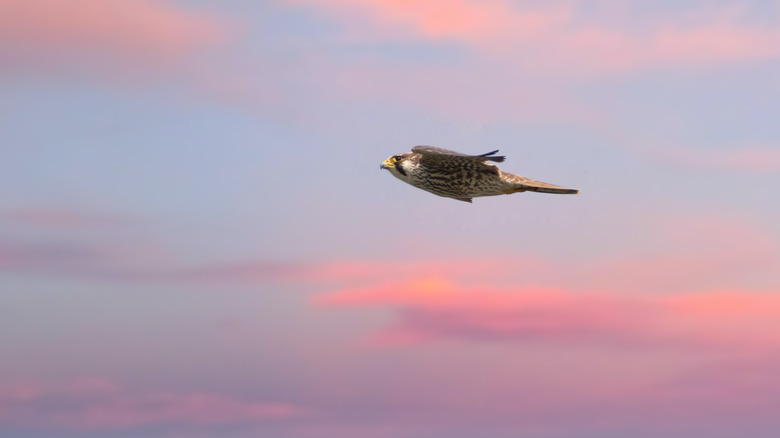The Wholesome Reason Zion National Park Closes Some Iconic Climbs To The Public
There are so many reasons to visit Zion National Park. It has incredibly beautiful scenery and a plethora of things to do, including hiking, canyoneering, horseback riding, biking, desert photography, stargazing, and more. People also flock to the park to climb its majestic sandstone cliffs, some of which tower 2,000 feet above the canyon floor. Those daring enough to give Zion's big wall climbing scene a whirl can do so via famous multi-pitch climbs such as Prodigal Sun or the Lowe Route on Angel's Landing.
However some of these climbing areas close to the public a portion of each year for a very good reason — to protect high-flying peregrine falcons, who return to the park each spring with their mates to build their nests as high as 1,300 feet off the ground in lofty crags and towers. Zion's lead wildlife biologist Janice Stroud-Settles told St. George News what could happen if climbers were to disturb the monogamous couples, for whom mating is serious business: "If they are forced off their nests, they may not return, and that's why it's so important that we do not disturb them at this critical time of year." It makes sense — probably the last thing a falcon couple needs when preparing for their next brood is a bunch of red-faced, sweaty climbers peering into their business and making a bunch of noise.
What to know about climbing closures at Zion National Park
Falcon nesting season lasts from about March through early fall — a decent chunk of the year. But the good news is that not all Zion climbing areas stay closed for the entirety of the nesting season. Only places where the park's wildlife biologists have spotted active nests close; these nests usually number 8 to 10 per year. Climbing areas without active nests reopen late in April or early in May, while those where current nests have been identified remain closed and are observed throughout the summer. After the juvenile birds leave the nests — often in July or August — the park reopens the nesting areas to climbers.
In the meantime, local climbers from the Zion Climbing Coalition help the park manage the process. "We are assisting the Zion National Park wildlife crew in coordinating volunteers to aid the technicians in having more eyes to be able to more effectively open and close the cliffs," said Zion Climbing Coalition's executive director, Steffan Gregory, per St. George News. The key role of volunteers, then, is to keep track of the routines of birds to know when a nest has been established or vacated. These volunteers could be climbers or simply those with an interest in birds who want to go out in the park and play wildlife biologist for a day. By the way, if you're a bird lover, check out our article on the best birdwatching destination in the U.S.
What you can do in the park during nesting season
For the most up-to-date information on climbing area closures and openings, check the National Park Service website. If your big wall plans in Zion have been derailed by nesting-related closures, you could always head to this top-ranked U.S. rock climbing destination that's only a 2.5 hour drive away. But here are a few other suggestions about how you might spend your time if you decide to stick around Zion. Hike one of the many amazing trails in the park, such as the short but magnificent Canyon Overlook or the surreal Lower, Middle, or Upper Emerald Pool Trails.
To simulate a climber's euphoria, ascend Angels Landing via the West Rim Trail, a route known for its narrow ridge and dizzying drop-offs into sheer nothingness. On the higher sections of this trail, be on the lookout for falcons on the rock walls or zooming through the air at speeds of up to 200 miles per hour, making them the fastest creature on Earth. If you're really lucky, you might also spot an endangered California condor, which also nest on the rock walls, as Zion National Park happens to be a major part of their territory. Condors are the largest birds in North America. Sadly, fewer than 100 of these majestic creatures are estimated to be alive today.


